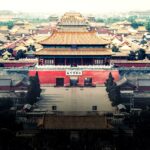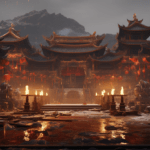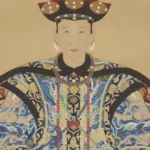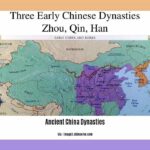The Han Dynasty (206 BCE – 220 CE), a period of remarkable growth and innovation, occupies a pivotal position in Chinese history. Its influence extends far beyond its impressive military achievements and territorial expansion, shaping the very fabric of Chinese culture, governance, and technological development for centuries to come. This article delves into the key aspects that define the Han Dynasty, exploring its rise, its remarkable achievements, and its eventual decline.
The Han’s Rise to Power: Uniting a Divided Nation
Following the collapse of the short-lived Qin Dynasty (221-206 BCE), China was plunged into chaos. Powerful warlords battled for control, creating a fragmented landscape of warring states. From this turmoil emerged Liu Bang, a charismatic leader who, after a protracted struggle known as the Chu-Han Contention (206-202 BCE), defeated his formidable rival, Xiang Yu, at the Battle of Gaixia. This hard-won victory marked the beginning of the Han Dynasty, laying the foundation for a unified China. Liu Bang, later Emperor Gaozu, didn’t simply conquer; he embarked on the monumental task of rebuilding a nation fractured by years of civil war.
Consolidating Power and Establishing a Centralized Government
The early years of the Han Dynasty were characterized by the consolidation of power and the establishment of a centralized government. Emperor Gaozu implemented crucial administrative reforms, instituting prefectures and counties to better manage the vast empire. He deftly navigated complex power dynamics within the court, balancing the influence of various factions to maintain stability. The reign of Empress Lü Zhi, Gaozu’s wife, who acted as regent after his death, is a notable example. Her policies, while controversial, played a significant role in shaping the early years of the dynasty. Some scholars, for instance, emphasize her role in strengthening the central government, while others point to the increased factionalism under her control.
The Western Han: A Time of Expansion and Prosperity
The Western Han (206 BCE – 9 CE) is often described as a golden age in Chinese history. Under Emperor Wu Di (141-87 BCE), the dynasty reached its zenith. His reign was marked by significant territorial expansion, robust economic growth, and an unprecedented cultural flourishing. Emperor Wu Di’s reign shows how careful expansionist policies and economic management can combine to create a flourishing dynasty. Some historians however, argue that this aggressive expansion policy eventually drained the empire’s resources and contributed to subsequent instability.
Technological and Scientific Advancements
The Han Dynasty witnessed groundbreaking advances in technology and science. The invention of papermaking, arguably one of humanity’s most significant achievements, revolutionized communication, record-keeping, and education. Other notable innovations include the seismograph, used to detect earthquakes, advancements in astronomy and timekeeping (sundials, water clocks), and improved agricultural techniques incorporating iron tools. These developments significantly impacted daily life, enabling greater efficiency and facilitating the expansion of knowledge.
The Silk Road: A Bridge to the West
The Han Dynasty’s economic prosperity was closely linked to the burgeoning Silk Road. This extensive network of trade routes connected China to the West, facilitating an unprecedented exchange of goods, ideas, and cultures. While the Silk Road’s full development wasn’t solely a Han creation, their rule and security along these routes undoubtedly fueled its growth and influence. The economic benefits were substantial, but the cultural exchanges and dissemination of knowledge were equally significant. The Silk Road fostered the flow of ideas between East and West and significantly shaped regional cultural interactions.
The Eastern Han: Challenges and Decline
The Eastern Han (25–220 CE), while marked by periods of prosperity, also faced significant challenges that ultimately contributed to its demise. Internal conflicts among powerful landowning families weakened the central government’s authority, leading to increasing instability. Economic imbalances, including land concentration in the hands of the elite and growing peasant unrest, added to the mounting pressure.
The Yellow Turban Rebellion: A Turning Point
The Yellow Turban Rebellion (184-205 CE), a massive peasant uprising fueled by economic hardship, social inequality, and religious fervor, exposed the profound vulnerabilities of the Eastern Han government and dealt a devastating blow to its authority. While it was ultimately suppressed, the rebellion signaled the empire’s decline and marked a distinct turning point. The Yellow Turban Rebellion’s scale and impact are notable. However, some historians suggest the rebellion was less a fundamental cause of the Han’s fall and more of a symptom of deeper problems already eating away at the empire.
The Rise of Warlords and the End of an Era
The failure to effectively quell the rebellion further weakened the empire, paving the way for the rise of ambitious warlords who sought to seize control of various regions. The ensuing power struggles plunged China into further turmoil, culminating in the Battle of Red Cliffs (208-209 CE), a pivotal engagement that shattered any remaining hope for a unified Han under Cao Cao. By 220 CE, Emperor Xian abdicated, marking the formal end of the Han Dynasty and ushering in the Three Kingdoms period.
The Enduring Legacy of the Han Dynasty
Despite its eventual decline, the Han Dynasty’s influence lingers profoundly. Its centralized bureaucratic system, based partly on meritocratic principles (civil service examinations), served as a model for governance in China for centuries. Its advancements in technology, particularly papermaking, had a global impact. The Silk Road, while not a Han invention, flourished under their rule, fostering unprecedented cultural exchange. The Han’s influence on art, philosophy, and social structures continues to shape Chinese culture today. The Han Dynasty stands as a testament to the dynamism and fragility of empires, embodying both remarkable achievements and the inherent challenges of maintaining power and order across a vast and diverse realm. Ongoing research continues to refine our understanding of this pivotal era, emphasizing its complexities and enduring legacy.
[https://www.lolaapp.com/celebrate-Cooperstown] [https://www.lolaapp.com/charles-dickens-birthplace-Portsmouth]
- Senior at What Age: Benefits & Eligibility Guide - March 29, 2025
- Unlocking Senior Benefits: How Old is a Senior? Your Complete Guide - March 29, 2025
- Master Russian Politeness:A Guide to Saying Please - March 29, 2025
















